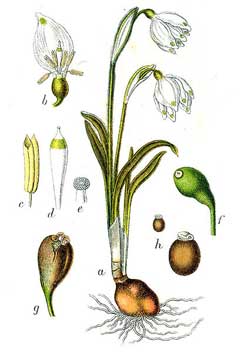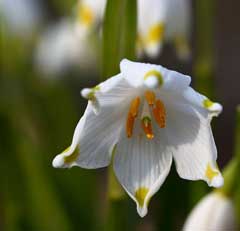 |
|
http://commons.wikimedia.org/wiki/File:Leucojum_vernum_Sturm47.jpg |
 |
| http://commons.wikimedia.org/wiki/User:Hedwig_Storch |
Translate this page:
Summary
Physical Characteristics

 Leucojum vernum is a BULB growing to 0.2 m (0ft 8in) by 0.1 m (0ft 4in).
Leucojum vernum is a BULB growing to 0.2 m (0ft 8in) by 0.1 m (0ft 4in).
See above for USDA hardiness. It is hardy to UK zone 5 and is not frost tender. It is in flower from March to April, and the seeds ripen in July. The species is hermaphrodite (has both male and female organs) and is pollinated by Bees.
It is noted for attracting wildlife.
Suitable for: light (sandy), medium (loamy) and heavy (clay) soils. Suitable pH: mildly acid, neutral and basic (mildly alkaline) soils and can grow in very alkaline soils.
It can grow in full shade (deep woodland) or semi-shade (light woodland). It prefers moist soil.
UK Hardiness Map
US Hardiness Map
Synonyms
Plant Habitats
Woodland Garden Dappled Shade; Shady Edge; not Deep Shade; Meadow; Hedgerow;
Edible Uses
References More on Edible Uses
Medicinal Uses
Plants For A Future can not take any responsibility for any adverse effects from the use of plants. Always seek advice from a professional before using a plant medicinally.
None known
References More on Medicinal Uses
The Bookshop: Edible Plant Books
Our Latest books on Perennial Plants For Food Forests and Permaculture Gardens in paperback or digital formats.

Edible Tropical Plants
Food Forest Plants for Hotter Conditions: 250+ Plants For Tropical Food Forests & Permaculture Gardens.
More

Edible Temperate Plants
Plants for Your Food Forest: 500 Plants for Temperate Food Forests & Permaculture Gardens.
More

More Books
PFAF have eight books available in paperback and digital formats. Browse the shop for more information.
Shop Now
Other Uses
References More on Other Uses
Cultivation details
Easily grown in ordinary garden soil[1, 90]. Prefers an open rich moist limy soil[1, 42]. Succeeds in shade or semi-shade[90]. If naturalizing in short grass, a light, well-drained soil is essential[245]. The dormant bulbs are fairly hardy and will withstand soil temperatures down to at least -5°c[214]. A very ornamental plant[1]. The flowers have a powerful scent that is likened by some to hawthorns and by others to violets[245]. Members of this genus are rarely if ever troubled by browsing deer or rabbits[233]. A good bee plant[108]. Plants can be naturalized in damp rough grass[200].
References Carbon Farming Information and Carbon Sequestration Information
Temperature Converter
Type a value in the Celsius field to convert the value to Fahrenheit:
Fahrenheit:
The PFAF Bookshop
Plants For A Future have a number of books available in paperback and digital form. Book titles include Edible Plants, Edible Perennials, Edible Trees,Edible Shrubs, Woodland Gardening, and Temperate Food Forest Plants. Our new book is Food Forest Plants For Hotter Conditions (Tropical and Sub-Tropical).
Shop Now
Plant Propagation
The seed is best sown as soon as it is ripe in a well-drained soil in a cold frame. Stored seed requires 2 - 3 months cold stratification, it should then germinate in 2 - 4 weeks at 10°c[134]. Sow the seed thinly so that the seedlings can be allowed to grow on undisturbed in the pots for their first year of growth. Give them an occasional weak liquid feed to ensure that they do not become nutrient deficient. Pot up the small bulbs when dormant, planting 2 - 3 bulbs in each pot. Grow them on for another 2 - 3 years before planting them out. Division of offsets in September/October. It is best done as soon as the foliage ripens[1]. Scooping the bulbs.
Other Names
If available other names are mentioned here
Native Range
EUROPE: Czechoslovakia, Austria, Belgium, Switzerland, Germany, Hungary, Poland (south), Former Yugoslavia, Italy (north), Romania, Spain (northeast), France
Weed Potential
Right plant wrong place. We are currently updating this section.
Please note that a plant may be invasive in one area but may not in your area so it's worth checking.
Conservation Status
IUCN Red List of Threatened Plants Status :

Growth: S = slow M = medium F = fast. Soil: L = light (sandy) M = medium H = heavy (clay). pH: A = acid N = neutral B = basic (alkaline). Shade: F = full shade S = semi-shade N = no shade. Moisture: D = dry M = Moist We = wet Wa = water.
Now available:
Food Forest Plants for Mediterranean Conditions
350+ Perennial Plants For Mediterranean and Drier Food Forests and Permaculture Gardens.
[Paperback and eBook]
This is the third in Plants For A Future's series of plant guides for food forests tailored to
specific climate zones. Following volumes on temperate and tropical ecosystems, this book focuses
on species suited to Mediterranean conditions—regions with hot, dry summers and cool, wet winters,
often facing the added challenge of climate change.
Read More
Expert comment
Author
L.
Botanical References
17200
Links / References
For a list of references used on this page please go here
Readers comment
© 2010, Plants For A Future. Plants For A Future is a charitable company limited by guarantee, registered in England and Wales. Charity No. 1057719, Company No. 3204567.